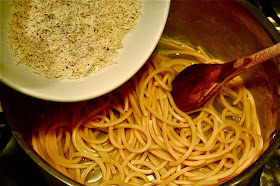Monday, November 3, 2014
Roman Classic: Cacio e Pepe
A few years back, in the dead of an interminable Maine winter no less, my friend Joe began to email enticing food photos from Rome, where he and his wife Joel were holed up for a month. There was the Carciofi alla Giuda (fried artichokes, Jewish style), the Trippa alla Romana (tripe in tomato sauce with cheese and mint), the Puntarelle in Salsa d'Acciughe (chicory salad with anchovy dressing) and of course Una Grande Varietà di Pizza (lots and lots of pizza).
But the one type of photo that wound up most frequently in my inbox was of Spaghetti a Cacio e Pepe, literally with nothing but cheese and black pepper.
Joe and I are alike in this way. We enjoy the simplest things best.
I can't tell you how many times I've decided not to share a recipe for cacio e pepe with you here. After all, do you really need me to tell you to dump some grated cheese over a pile of spaghetti? But the bigger reason is this: I find it difficult to make a really good cacio e pepe. A traditional one anyway, where the only ingredients are the cheese and the pepper, plus pasta and a little bit of, well, water.
Start adapting the dish by adding things like olive oil or butter or even a little cream and your chances of success are far greater. (I had a fine, if a bit modernized, cacio e pepe just the other evening at my go-to local spot, Enio's.) But go the old-school Roman route, as I do, and, well, you take your chances. Technique becomes way more critical, I think. Failure isn't only an option, it's a distinct probability. Joe, for instance, tells me that he has "never gotten it right — not once!"
I know. I should just shut up already and cook. Fine, have it your way.
Just don't come crying to me if things don't work out for you the first time you try this. Or even the second, come to think of it.
First of all, I'm only working with 1/2 lb. of pasta here, so double the ingredients if you're making a full pound. This is around a cup of grated cheese and a heaping teaspoon of freshly ground black pepper. We're all friends here and so I'll be straight with you. I used a combination of two different cheeses this time, Pecorino and Parmigiano-Reggiano (see the color variation?). But I'd suggest using all Pecorino instead. The saltier cheese makes for a better cacio e pepe, I think; plus, it's more traditional to use Pecorino. And don't skimp on the pepper either. It's important.
Mix the cheese and pepper thoroughly.
Boil your pasta (spaghetti alla chitarra here) in well-salted water. When the pasta is done reserve some of the water before draining (1/2 cup should be enough for a full pound of pasta).
Return the drained pasta to the pot that you cooked it in, but make sure the heat is off. Add some of the pasta water (1/4 cup per half pound of pasta is a good guide) and stir so that the pasta is evenly moistened.
This is the tricky part. And I won't lie to you either: I only get it right maybe half the time. You've got to very gradually stir in the cheese — and then pray that it doesn't clump up rather than coat the pasta evenly. My best advice is to go slowly — and practice, practice, practice. (There's a reason I've only used 1/2 lb. of pasta here, you know.) Either that or use another recipe. I won't mind.
Believe me, there are way more fool-proof methods of making cacio e pepe than this hardcore traditional one.
Just ask Joe, he'll tell you.








Refrigerate the cheese for 3 or 4 minutes before adding. It reduces the surface moisture and the "innate desire" to clump -- because the little dears are shivering.
ReplyDeleteI used pecorino romano and added butter and olive oil. Still it was delicious
ReplyDelete/Users/mcouture/Desktop/IMG_0599.jpg
I haven't had time to read your blog until now on vacation. I think I'll have cacio e Pepe tonight at one of our favorite ristorante, Alla Cancelleria. You've inspired me. Not to cook, but to eat!!
ReplyDeleteRoma huh?
ReplyDeleteJealous.
Molto.